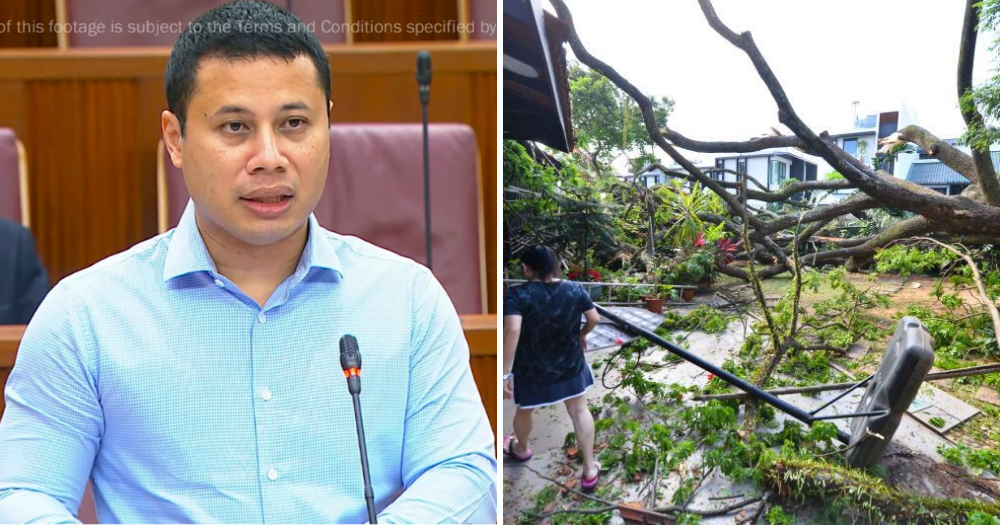Follow us on Telegram for the latest updates: https://t.me/mothershipsg
In the morning of Feb. 18, a woman in her 30s was tragically killed by a tree that fell on her in Marsiling Park.
Then, on Mar. 1, a rain tree in Bukit Timah fell on a condominium, damaging four units and three cars.
In Parliament on Wednesday (Mar. 3), Minister for National Development Desmond Lee explained the National Parks Board's (NParks) inspection process of trees, saying that any death or injury from a fallen tree is "one too many".
NParks' inspectors carry out regular tree inspections
Responding to questions from Members of Parliament (MPs) Hany Soh and Shawn Huang about the inspection of trees, Lee said that NParks "has a tree inspection and maintenance regime that is aligned with the Best Management Practices of the International Society of Arboriculture (ISA)".
Lee said that NParks manages around six million trees in Singapore.
Trained inspectors carry out regular tree inspections every six to 24 months, Lee said, depending on the location and size of the tree. Trees close to areas with high pedestrian or traffic activity are inspected more frequently.
There are currently more than 620 accredited arborists in Singapore.
During inspections, NParks' inspectors do a "comprehensive visual examination" of the tree crown, branches, trunk, and roots in order to assess the trees' health and stability.
Trees with possible defects are then subject to an additional in-depth inspection, which involves the use of diagnostic equipment to assess the internal condition of the tree, Lee said.
NParks works closely with agencies that manage trees
Starting in Nov. 2016, trees that are more than four metres wide are also subject to an annual in-depth inspection, as a precautionary measure in response to changing weather conditions.
Responding to MP Yip Hon Weng's question about how NParks works with town councils on the management of trees outside of parks and in HDB estates, Lee said that NParks works closely with agencies that manage trees, town councils, and land owners to advise them on tree care standards.
He added that NParks provides free professional training courses and seminars for tree care professionals in the private sector and public agencies that manage trees.
Other measures to reduce risk of tree failure
Lee also laid out other measures that NParks has taken to reduce the risk of tree failure.
First, NParks carries out targeted arboriculture treatments to improve trees' health and ability to withstand severe weather conditions. Trees are also pruned regularly to remove weak, dry, or overgrown branches, and to improve their structure and balance.
Additionally, NParks is progressively replacing tree species that are vulnerable to storms with hardier species.
Thirdly, NParks utilises technology to analyse risks and improve the inspection process; for example, NParks is piloting modelling techniques to understand the impact of adverse environmental conditions, such as strong winds, on the structural integrity of trees.
Through NParks' tree management programme, Lee said, the number of tree failure incidents has been reduced from 3,100 in 2000 to 339 in 2020, a reduction by almost a factor of nine.
However, Lee added:
"It is not possible to completely prevent tree-related incidents because trees are living organisms that can be affected by pests and diseases, as well as environmental conditions.
Even healthy and structurally-sound trees can fail during storm events due to exceptionally strong winds or heavy rainfall."
He also addressed the Marsiling Park incident, saying:
"We deeply regret the loss of life. Every one — death or injury — as a result of tree fall incidents is one too many.
[...] We’ll continue to press on, to keep up the work, and to ensure that our nature is safe and enjoyable for everyone."
Possibility of providing more structural support to trees
In a follow-up clarification, Soh asked whether the Ministry of National Development (MND) could consider implementing measures that improve the structural support of trees in parks and other areas with high human traffic — such as by using cables — or to tie trees so that they would fall away from human traffic.
Lee responded that NParks uses tree support systems for some trees, such as those that have reached maturity or that have known structural weaknesses.
For example, he said that there is a lychee tree in Novena that is more than 100 years old, which is supported by a permanent galvanised steel structure built to withstand the elements.
In other cases, such as a Palaquium tree in the Botanic Gardens, NParks uses cabling methods as a precautionary measure, to keep the tree from falling in the direction of the footpath.
However, Lee added that tree support systems have the potential to restrain young and semi-mature trees in their ability to grow, and could constrain their ability to naturally sway as a way to buffer the impact of strong winds.
Constraining a tree's natural movement could actually inadvertently weaken the tree's structure, Lee said.
He added that NParks will carefully study what situation structural supports can be used in, but also that they recognise that structures can pose safety issues if used without care in park settings frequented by people.
Members of the public with feedback on public trees or park facilities can contact NParks via its hotline at 1-800-471-7300, or through the OneService app.
For park-related accidents or incidents, the public should contact the police or the SCDF immediately, if there is an emergency, or the NParks hotline otherwise. Members of the public may also approach NParks officers who are stationed on-site at some parks during office hours.
Related stories:
Totally unrelated but follow and listen to our podcast here
Top photos via YouTube / MCI and Shin Min Daily.
If you like what you read, follow us on Facebook, Instagram, Twitter and Telegram to get the latest updates.
